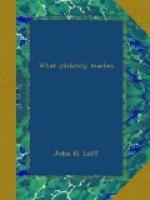“The hand placed above the gates of the Alhambra, upon the Sultan’s seal, and upon the stamps, symbolises the spiritual and temporal power which protects the good and the faithful and punishes their adversaries.”
[Illustration: Stamp, “Korea”, 5 Poon]
This stamp is from Corea, the Land of the Morning Calm. In the corners are the plum blossom, the royal flower of the present dynasty which has existed over 500 years. In the four corners of the central square are letters taken from the original alphabet of all languages and representing the four spirits that stand at the four corners of the earth and support it on their shoulders. The central device is an ancient Chinese symbol which represents the dual principle in nature, the male and the female, the beginning and the end, the union of all opposite forces, of which the highest product is man. This symbol pervades all oriental art and thought. Those of you who have seen Vedder’s illustrations of the Rubaiyat of Omar Khayyam will remember the ever recurring swirl which “represents the gradual concentration of the elements that combine to form life; the sudden pause through the reverse of the movement that marks the instant of life, and then the gradual, ever-widening dispersion again of these elements into space.” The swirl is only another form of the Chinese symbol.
A postage stamp is a tiny thing but it holds in its pictured space thoughts that embrace the beginning and the end of things, life, death and—we know not what.
[Illustration]



